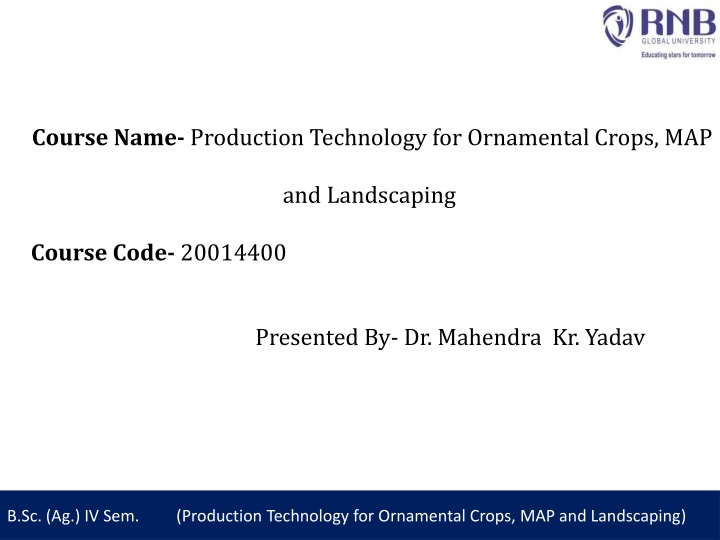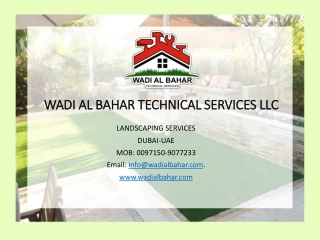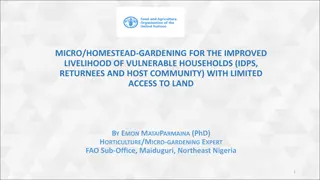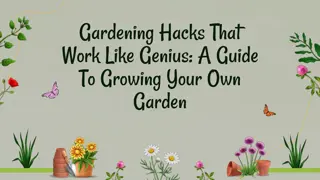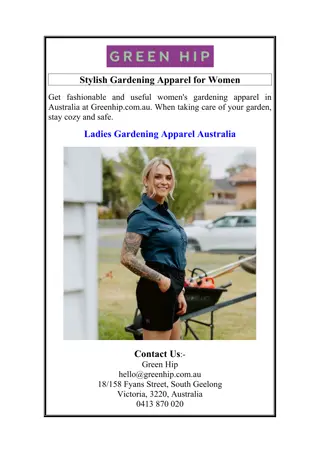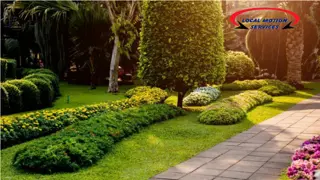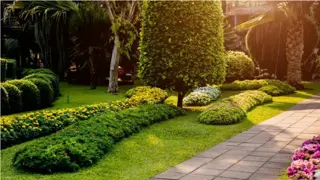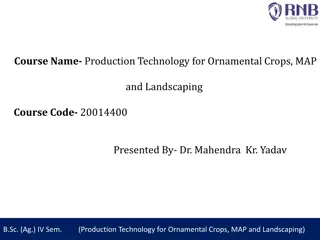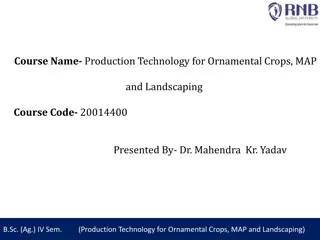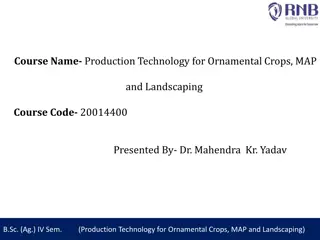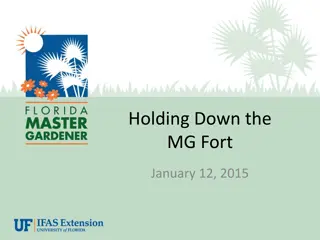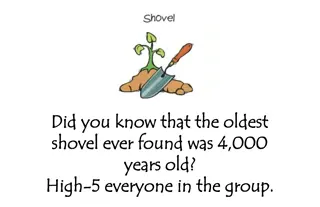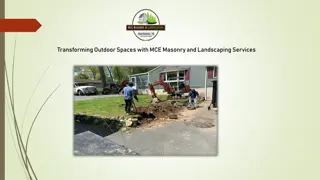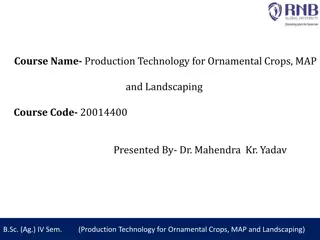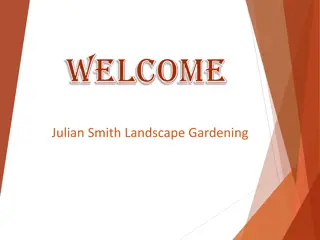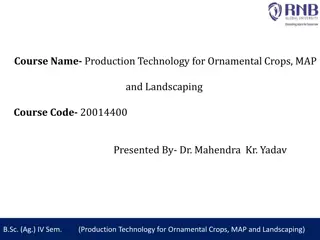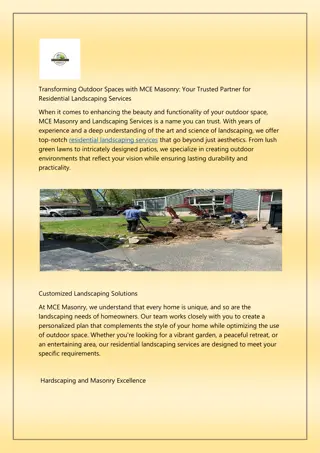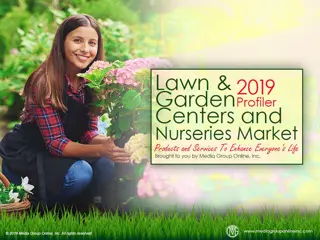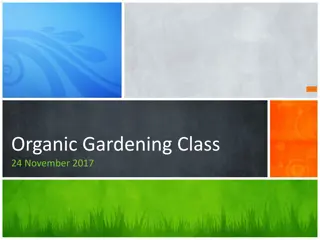Principles of Landscape Gardening and Landscaping Techniques
This course on production technology for ornamental crops, MAP, and landscaping covers the identification of ornamental and medicinal crops, principles of landscaping, uses of landscape trees, shrubs, and climbers, production technology of important ornamental crops, and more. It emphasizes the importance of processing and value addition in ornamental crops and MAPs. Topics include principles of landscape gardening, space management, balance, rhythm, proportion, and scale in garden design.
Download Presentation

Please find below an Image/Link to download the presentation.
The content on the website is provided AS IS for your information and personal use only. It may not be sold, licensed, or shared on other websites without obtaining consent from the author.If you encounter any issues during the download, it is possible that the publisher has removed the file from their server.
You are allowed to download the files provided on this website for personal or commercial use, subject to the condition that they are used lawfully. All files are the property of their respective owners.
The content on the website is provided AS IS for your information and personal use only. It may not be sold, licensed, or shared on other websites without obtaining consent from the author.
E N D
Presentation Transcript
Course Name- Production Technology for Ornamental Crops, MAP and Landscaping Course Code- 20014400 Presented By- Dr. Mahendra Kr. Yadav B.Sc. (Ag.) IV Sem. (Production Technology for Ornamental Crops, MAP and Landscaping)
Course Objectives Identify different types of ornamental and medicinal crops. Examine various principles of landscaping, uses of landscape trees, shrubs and climbers, production technology of important ornamental crops, etc. Determine about Demonstrate various Package of practices for loose flowers and their transportation, storage house and required condition for cut and loose flower. Construct about the various problems with the production technology of medicinal and aromatic plants. Importance of Processing and value addition in ornamental crops and MAPs produce. B.Sc. (Ag.) IV Sem. (Production Technology for Ornamental Crops, MAP and Landscaping)
Principles of landscaping. Landscape uses of trees, shrubs and climbers. B.Sc. (Ag.) IV Sem. (Production Technology for Ornamental Crops, MAP and Landscaping)
Principles of Landscape Gardening: There are some principles keep in mind when landscaping the garden. They are mentioned here. Axis: - This is an imaginary line in any garden round which the garden created striking balance. Unity:- Unity in a garden is very important and will improve the artistic look of thegarden. Unity has to be achieved from various angles It can be achieved by using mass planting and repetition. Mass effect:-The use of single plant species in large numbers in one place is done to have mass effect. One should see that such mass arrangements do not become monotonous; the sizes of masses should be varied Repetition:- It refers to repeated use of features like plants with identical shape, in form, texture and colour. Eg Hedge, Avenue planting Focal point:-A focal point in every garden is a centre of attraction which is generally an architectural feature focused as a point of interest such as statue, fountain, rockery etc. It involves the leading visual observation towards a feature by placement of the feature e.g. center of the garden, corner of the garden. B.Sc. (Ag.) IV Sem. (Production Technology for Ornamental Crops, MAP and Landscaping)
Space:-The aim of garden design should be such that the garden should appear larger than it actual size. The aim of every garden design should be such that the garden should appear larger than its actual size. One way of achieving this is to keep vast open spaces, preferably under lawn and restrict the plantings in the periphery, normally avoiding any planting in the centre Balance:- It refers to equilibrium or quality of usual attraction, Correct positioning of plants and features create well balanced design It is used to maintain optimum symmetry in garden. Rhythm:- Repetition of the same object at equal distance is called rhythm. Divisional Lines:- a landscape design there should not be such hard and fast divisional lines,the necessity of dividing or rather screening a compost pit or mail's quarter or a vegetable garden from the rest of the garden Proportion and Scale:- Proportion refers to the size of parts of the design in relation to each other and the design as a whole.Scale refers to the size of an object or objects in relation to the surroundings. Texture:- Texture describes the surface quality of an object than can be seen or left, surface in the landscape includes buildings, walks, ground covers and plants Time and Light:- A good planner must roughly take in to account the seasonal movement of the sun shade and light area likely to fall during different parts of the season B.Sc. (Ag.) IV Sem. (Production Technology for Ornamental Crops, MAP and Landscaping)
Colour:- Colour can be used to direct attraction in the land scape. Three basic colour schemes are i) Monochromatic ii) Analogous iii) Complementary Mobility:- Mobility means gradual changes or sudden change. Garden should be mobile. It can be obtained by the arrangement of objects with varying texture, forms or sizes in logical order. Garden style:- Garden styles have been changed from time to time with the new ideas and necessities. General Principles of Garden Design: Simplicity: Garden design should be simple. It should not have scope for under complexity. Visitors should catch entire effect. Visitors should know purpose of garden design/plan. Ideal garden should have space i.e. overcrowding of plants should be avoided. Judicious uses of more number of varieties/species of plants, instead of going for few plants go for more number of plants because it serves two purposes. a. Increases aesthetic beauty. b) Serves the scientific purpose B.Sc. (Ag.) IV Sem. (Production Technology for Ornamental Crops, MAP and Landscaping)
Garden path/ drive should not too straight and long. Garden should layout for owners comfort and convenience. Natural grade of greens taken in to consideration. All garden features should be accommodated in proper place in a proportionate manner, careful selection of plant and also increase beauty of garden. It should comfortable to living (Private garden). It should serve perfect place for passing leisure time. Easy to maintain to carry out all intercultural operations. When we say garden is complete garden should look beautiful and should give pleasant look to the garden. B.Sc. (Ag.) IV Sem. (Production Technology for Ornamental Crops, MAP and Landscaping)
There are three basic garden styles given as under: Difference between formal and informal garden: Formal garden Informal garden More stress on geometrical balance, each thing use very proportionate. Stress on natural balance by other principle rather than geometrically. 1. 1. 2. The figure is more important than idea. 2. The idea is more important than figure. 3. Even /leveled land. 3. Un leveled land is preferred. More importance on curved and round mass. 4. More importance on straightness. 4. 5. Balance is symmetrical. 5. Balance is asymmetrical. Annual and perennials both have equal importance. 6. 6. Perennials have more importance. Design is prepared according to the plan to be used. 7. 7. Plan is made fit to the landscape. 8. Highly dominated by rules. 8. Less dominated by rules. 9. It is creation of artificial scenery. 9. Creation of natural scenery. 10. Small area is required. 10. Large area is required. Types: Mughal, Persian, Italian & French garden. 11 11 Types: Japanese & English garden. B.Sc. (Ag.) IV Sem. (Production Technology for Ornamental Crops, MAP and Landscaping)
Use of Trees, Shrubs and Climber in the landscape/Garden: Trees: Trees are big, tall perennial plants having very thick and hard distinct stems called as trunk and crown at the top. This single main stem i.e, trunk give rises to many branches bearing leaves and fruits. 1. Trees are essential feature of a landscape garden, roadside planting, public parks, along railway line, in school and colleges and in private garden also. It provides shade, shelter and makes summer pleasant. Bears beautiful flowers and foliage. Some trees provide fruits. Trees plays important role in controlling pollution in cities and town. Some species of trees are used for beautification. Delight and refresh the eye with their green foliage. B.Sc. (Ag.) IV Sem. (Production Technology for Ornamental Crops, MAP and Landscaping)
Trees are used as avenue e.g .Amaltas, Cassia, Gulmohar, Ashok, Rain tree etc e.g. Flowering trees: Gulmohar (Delonix regia), Bottle brush (Callistemon lanceolatus) Ashoka (Saraca india), Pride of India (Lagerstroemia), Spathodea campanulata, Bahunia, Begonia, Palash (Butea monosperma,) Casia fistula (garmalo), etc. e.g. Foliage trees: Ashopalav (Polyalthia longifolia), Silver oak, Peltophorum inerme, Sharu (Casuriana equisetifplia), Siris (Albezia lebbek), Rain tree (Samane saman), Eucalyptus, Vad (Ficus bengalensis), Pipal (Ficus relegiosa), Rubber tree (Ficus elastic), etc. B.Sc. (Ag.) IV Sem. (Production Technology for Ornamental Crops, MAP and Landscaping)
Shrubs:Shrubs are plants with many woody branches arising from the base of the plant and are smaller (1 to 4 m in height) than trees but bigger than herbaceous plants. Shrubs are the chief attraction of ornamental garden with their handsome foliage, colorful flowers and attractive berries. They are perennial habit and need little care. Shrubs are ideally suited for topiary work, formal garden, landscape designing. It can be planted as single specimen in lawns or as tub plants. Shrubs can also be planted to secure privacy in the garden. Shrubs are use as Shrubbery border which is a source of perennial pleaser. Some shrubs can be grown along the paths. Shrubs can effectively break the monotony of a large open space in the garden e.g. flowering shrubs: Rose, jasmine, hibiscus, ixora, hemelia, lantana, narium, Tecoma stens, etc. e.g. foliage shrubs: Croton, duranta, acalypha, aralia, eranthemum, thuja, etc. B.Sc. (Ag.) IV Sem. (Production Technology for Ornamental Crops, MAP and Landscaping)
Climbers and Creepers: Climbers: Climbers are defined as a plant which possesses special structures to climb over a support. These special structures may be hook-hike thorns. Creepers are those plants which are unable to climb vertically on their own because of their weak stems. Uses of climbers in garden: Certain climbers are grown in gardens for their attractive foliage. e. g. Asparagus spregeri, Ficus repens, Hedera helix, Scindapsus aureus. Some light climbers can be trained as screens in gardens. e. g. Bignonia venusta, Jacquemontia violaceae, Passiflora edulis. Climbers like Allamanda, Antigonon, Aristolochia elegans, Solanum seaforthianum can be used on arches, bowers and pergolas. Heavy climbers like Bougainvillea, Quisqualis indica, Petrea volubilis, Adenocalymma allicea, Allamanda cathartica, Scindapsus, Petrea volubilis can be trained over strong pergolas or on trees which look very attractive. B.Sc. (Ag.) IV Sem. (Production Technology for Ornamental Crops, MAP and Landscaping)
The bare wall of building or boundary wall can be covered beautifully by a colorful climbers or a foliage type of climbers. Climbers can be used for the purpose of screening to maintain privacy from the adjacent houses. The climbers are also grown to be trained on trellis, pergolas, arches, arbours and against pillars or similar structures. Use for climb over net house or conservatories. Climbers are also suitable for roof gardens, where vertical growth is preferred because of lack of space. All over climber if properly used, they serve to brighten and cheer up a place. Climbers are very important ornamental plants and are commonly used on walls, arches and pergolas but in cities their utility is increased for the purpose of screening the premises from adjacent houses and maintaining privacy. Bare walls can be most effectively decorated by growing colorful climbers. Climbers and Creepers are important group of plants which add beauty, color in striking way of fragrance in gardens and artificial structures like wall, arches, pergola, pillars; topiary, etc. are well decorated with the help of climbers. B.Sc. (Ag.) IV Sem. (Production Technology for Ornamental Crops, MAP and Landscaping)
Difference between climbers and creepers SN Climbers Vs Creepers They tends to spread horizontally along the soil and. 1 They tend to grow vertically. 2 They climb on their own . They required support for climbing. 3 Do not posses special structures. They possess special structures to climb over a support like hook-hike, thorns, tendrils, etc. 4 Main stem is weak. Main stem is soft & very weak. eg. Bougainvillea, etc. Bignonia, Ficus repens, 5 eg. Morning glory, Railway creeper etc. B.Sc. (Ag.) IV Sem. (Production Technology for Ornamental Crops, MAP and Landscaping)
